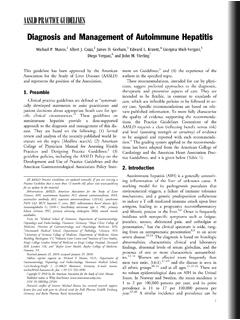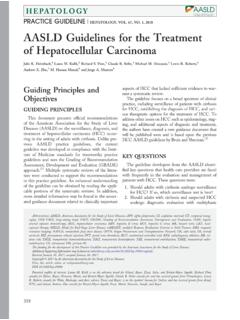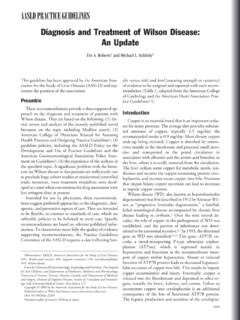Transcription of Hepatic Encephalopathy in Chronic Liver Disease: 2014 ...
1 PRACTICE GUIDELINEH epatic Encephalopathy in Chronic Liver Disease: 2014 Practice Guideline by AASLD and EASLH endrik Vilstrup Piero Amodio Jasmohan Bajaj Juan Cordoba Peter Ferenci Kevin D. Mullen Karin Weissenborn Philip WongJump to:CONTENTSRECOMMENDATIONSFULL TEXTREFERENCESFORWARD 2014 The American Association for the Study of Liver Diseases, All rights reserved. 2014 The American Association for the Study of Liver Diseases, All rights TEXTREFERENCESRECOMMENDATIONSWEB SITECONTENTSH epatic Encephalopathy in Chronic Liver disease : 2014 Practice Guideline by AASLD and EASLAASLD PRACTICE GUIDELINECONTENTSC ontents (click section title or page number)Recommendations and Rationales ..3 Full-text Guideline ..40 Abbreviations ..41 Preamble ..42 Literature Review and Analysis ..43 Introduction ..43 Definition of the disease /Condition.
2 44 Diagnosis and Testing ..50 Treatment ..54 Alternative Causes of Altered Mental Status ..61 Follow-up ..62 Suggestions for Future Research ..64 References ..67 FORWARDBACKUSING, SEARCHING, AND PRINTING GUIDELINESThis document was designed for use on a variety of devices using Adobe Acrobat Reader. Smaller screens should be held horizontally. You may search or print using your PDF viewer. Menu hyperlinks allow movement between sections and to the guidelines on the AASLD site. In Recommendations and Rationales, click on individual items to review specific rationales. Use the top menu to return to the list. This file reflects the most recently approved language of the published guideline. Your feedback is welcome on the design and usability and will help guide future publications. Please email your comments to or visit our social media pages. 2014 The American Association for the Study of Liver Diseases, All rights TEXTREFERENCESRECOMMENDATIONSWEB SITECONTENTSH epatic Encephalopathy in Chronic Liver disease : 2014 Practice Guideline by AASLD and EASLAASLD PRACTICE GUIDELINERECOMMENDATIONSR ecommendations and Rationales1.
3 Hepatic Encephalopathy (HE) should be classified according to the type of underlying disease , severity of manifestations, time course, and precipitating factors (GRADE III, A, 1).2. A diagnostic workup is required, considering other disorders that can alter brain function and mimic HE (GRADE II-2, A, 1).3. Hepatic Encephalopathy should be treated as a continuum ranging from unimpaired cognitive function with intact consciousness through coma (GRADE III, A, 1).4. The diagnosis of HE is through exclusion of other causes of brain dysfunction (GRADE II-2, A, 1).5. Hepatic Encephalopathy should be divided into various stages of severity, reflecting the degree of self-sufficiency and the need for care (GRADE III, B, 1).6. Overt Hepatic Encephalopathy is diagnosed by clinical criteria and can be graded according the West Haven Criteria and the Glasgow Coma Scale (GRADE II-2, B, 1).
4 7. The diagnosis and grading of minimal HE and covert HE can be made using several neurophysiological and psychometric tests that should be performed by experienced examiners (GRADE II-2, B, 1).8. Testing for minimal HE and covert HE could be used in patients who would most benefit from testing, such as those with impaired quality of life or implication on employment or public safety (GRADE III, B, 2).9. Increased blood ammonia alone does not add any diagnostic, staging, or prognostic value for HE in patients with Chronic Liver disease . A normal value calls for diagnostic reevaluation (GRADE II-3, A, 1).General recommendations for treatment of episodic overt HE type C include the following (#10 to #13):10. An episode of overt HE (whether spontaneous or precipitated) should be actively treated (GRADE II-2, A, 1).11. Secondary prophylaxis after an episode for overt HE is recommended (GRADE I, A, 1).
5 12. Primary prophylaxis for prevention of episodes of overt HE is not required, except in patients with cirrhosis with a known high risk to develop HE (GRADE II-3, C, 2).13. Recurrent intractable overt HE, together with Liver failure, is an indication for Liver transplantation (GRADE I). Specific approach to overt HE treatment: A four-pronged approach to management of HE is recommended (GRADE II-2, A, 1) (#14 to #17):14. Initiation of care for patients with altered consciousness15. Alternative causes of altered mental status should be sought and Identification of precipitating factors and their correctionThis guideline includes 33 specific recommendations. Please click on a recommendation to review the related rationale and supporting evidence. See Table 1 for an explanation of the grading system for 2014 The American Association for the Study of Liver Diseases, All rights TEXTREFERENCESRECOMMENDATIONSWEB SITECONTENTSH epatic Encephalopathy in Chronic Liver disease : 2014 Practice Guideline by AASLD and EASLAASLD PRACTICE GUIDELINERECOMMENDATIONS17.
6 Commencement of empirical HE treatment18. Identify and treat precipitating factors for HE (GRADE II-2, A, 1).19. Lactulose is the first choice for treatment of episodic overt HE (GRADE II-1, B, 1).20. Rifaximin is an effective add-on therapy to lactulose for prevention of overt HE recurrence (GRADE I, A, 1).21. Oral branched-chain amino acids can be used as an alternative or additional agent to treat patients nonresponsive to conventional therapy (GRADE I, B, 2).22. Intravenous L-ornithine L-aspartate can be used as an alternative or additional agent to treat patients nonresponsive to conventional therapy (GRADE I, B, 2).23. Neomycin is an alternative choice for treatment of overt HE (GRADE II-1, B, 2).24. Metronidazole is an alternative choice for treatment of overt HE (GRADE II-3, B, 2).25. Lactulose is recommended for prevention of recurrent episodes of HE after the initial episode (GRADE II-1, A, 1).
7 26. Rifaximin as an add-on to lactulose is recommended for prevention of recurrent episodes of HE after the second episode (GRADE I, A, 1).27. Routine prophylactic therapy (lactulose or rifaximin) is not recommended for the prevention of post-transjugular intrahepatic portosystemic shunt (TIPS) HE (GRADE III, B, 1).28. Under circumstances where the precipitating factors have been well controlled ( , infections and variceal bleeding) or Liver function or nutritional status improved, prophylactic therapy may be discontinued (GRADE III, C, 2).29. Treatment of minimal HE and covert HE is not routinely recommended apart from a case-by-case basis (GRADE II-2, B, 1).30. Daily energy intakes should be 35-40 kcal/kg ideal body weight (GRADE I, A, 1).31. Daily protein intake should be g/kg/ day (GRADE I, A, 1).32. Small meals or liquid nutritional supplements evenly distributed throughout the day and a latenight snack should be offered (GRADE I, A, 1).
8 33. Oral branched-chain amino acid supplementation may allow recommended nitrogen intake to be achieved and maintained in patients intolerant of dietary protein (GRADE II-2, B, 2).FORWARDBACK 2014 The American Association for the Study of Liver Diseases, All rights TEXTREFERENCESRECOMMENDATIONSWEB SITECONTENTSH epatic Encephalopathy in Chronic Liver disease : 2014 Practice Guideline by AASLD and EASLAASLD PRACTICE GUIDELINERECOMMENDATIONSRECOMMENDATION 1 Hepatic Encephalopathy (HE) should be classified according to the type of underlying disease , severity of manifestations, time course, and precipitating factors (GRADE III, A, 1).RATIONALE 1 Definition of HEHepatic Encephalopathy is a brain dysfunction caused by Liver insufficiency and/or PSS; it manifests as a wide spectrum of neurological or psychiatric abnormalities ranging from subclinical alterations to Encephalopathy should be classified according to all of the following four According to the underlying disease , HE is subdivided into Type A resulting from ALF Type B resulting predominantly from portosystemic bypass or shunting Type C resulting from cirrhosisThe clinical manifestations of types B and C are similar, whereas type A has distinct features and, notably, may be associated with increased intracranial pressure and a risk of cerebral herniation.
9 The management of HE type A is described in recent guidelines on ALF62,63 and is not included in this According to the severity of manifestations. The continuum that is HE has been arbitrarily subdivided. For clinical and research purposes, a scheme of such grading is provided (Table 2). Operative classifications that refer to defined functional impairments aim at increasing intra- and inter-rater reliability and should be used whenever According to its time course, HE is subdivided into Episodic HE Recurrent HE denotes bouts of HE that occur with a time interval of 6 months or less. Persistent HE denotes a pattern of behavioral alterations that are always present and interspersed with relapses of overt According to the existence of precipitating factors, HE is subdivided into Nonprecipitated or Precipitated, and the precipitating factors should be specified.
10 Precipitating factors can be identified in nearly all bouts of episodic HE type C and should be actively sought and treated when found (Table 3).Every case and bout of HE should be described and classified according to all four factors, and this should be repeated at relevant intervals according to the clinical situation. The recommendations are summarized in Table TO RECOMMENDATIONS LISTFORWARDBACK 2014 The American Association for the Study of Liver Diseases, All rights TEXTREFERENCESRECOMMENDATIONSWEB SITECONTENTSH epatic Encephalopathy in Chronic Liver disease : 2014 Practice Guideline by AASLD and EASLAASLD PRACTICE GUIDELINERECOMMENDATIONSRECOMMENDATION 2A diagnostic workup is required, considering other disorders that can alter brain function and mimic HE (GRADE II-2, A, 1).RATIONALE 2 The diagnosis requires the detection of signs suggestive of HE in a patient with severe Liver insufficiency and/or PSS who does not have obvious alternative causes of brain dysfunction.












